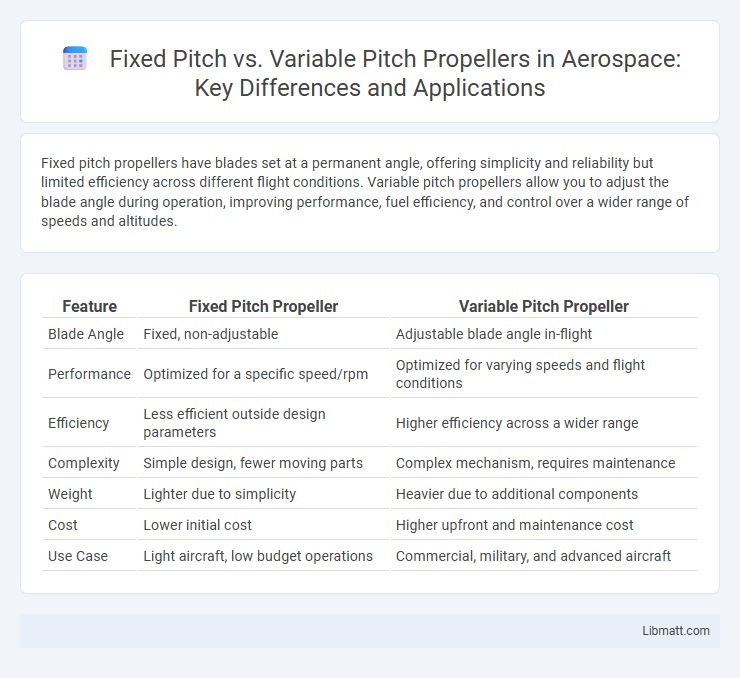Fixed pitch propellers have blades set at a permanent angle, offering simplicity and reliability but limited efficiency across different flight conditions. Variable pitch propellers allow you to adjust the blade angle during operation, improving performance, fuel efficiency, and control over a wider range of speeds and altitudes.
Table of Comparison
| Feature | Fixed Pitch Propeller | Variable Pitch Propeller |
|---|---|---|
| Blade Angle | Fixed, non-adjustable | Adjustable blade angle in-flight |
| Performance | Optimized for a specific speed/rpm | Optimized for varying speeds and flight conditions |
| Efficiency | Less efficient outside design parameters | Higher efficiency across a wider range |
| Complexity | Simple design, fewer moving parts | Complex mechanism, requires maintenance |
| Weight | Lighter due to simplicity | Heavier due to additional components |
| Cost | Lower initial cost | Higher upfront and maintenance cost |
| Use Case | Light aircraft, low budget operations | Commercial, military, and advanced aircraft |
Introduction to Fixed Pitch and Variable Pitch
Fixed pitch propellers have blades set at a specific angle that cannot be changed during operation, offering simplicity and reliability for consistent performance in specific conditions. Variable pitch propellers adjust the blade angle dynamically, enhancing efficiency, control, and fuel economy by optimizing thrust according to flight or engine demands. Understanding the distinction between fixed pitch and variable pitch systems helps you select the right propeller type to suit your aircraft's performance needs and operational flexibility.
Key Differences Between Fixed Pitch and Variable Pitch
Fixed pitch propellers have blades set at a single angle, offering simplicity, lower cost, and consistent performance but lack adaptability to changing flight conditions. Variable pitch propellers allow blade angles to be adjusted during operation, enhancing efficiency, thrust control, and fuel economy across different speeds and loads. Understanding these key differences can help you choose the best propeller type for optimal aircraft performance and fuel management.
How Fixed Pitch Propellers Work
Fixed pitch propellers have blades set at a permanent angle, optimizing performance for specific flight conditions by maintaining a constant blade pitch during operation. These propellers convert engine power directly into thrust through consistent aerodynamic force, providing simplicity and reliability without the complexity of adjustable mechanisms. Commonly used in smaller aircraft, fixed pitch designs prioritize efficiency at cruising speeds but may lack versatility across varying flight phases compared to variable pitch alternatives.
How Variable Pitch Propellers Operate
Variable pitch propellers adjust the blade angle dynamically to optimize thrust and efficiency across different flight conditions. Actuated by mechanical, hydraulic, or electric systems, these propellers change blade pitch to maintain optimal aerodynamic performance and fuel economy. This adaptability allows aircraft to improve takeoff power, cruising efficiency, and overall control compared to fixed pitch propellers.
Advantages of Fixed Pitch Solutions
Fixed pitch propellers offer lower manufacturing and maintenance costs due to their simpler design, making them ideal for budget-conscious applications. Their consistent blade angle ensures reliable performance and ease of installation without the complexity of adjustable mechanisms. For Your needs, fixed pitch solutions provide durability and efficiency in steady operating conditions.
Advantages of Variable Pitch Technology
Variable pitch technology enhances the efficiency and performance of propellers by allowing blades to adjust their angle in real-time according to flight conditions. This adaptability results in improved fuel economy, increased thrust, and reduced engine strain compared to fixed pitch propellers. Variable pitch systems also provide better control and maneuverability, making them essential in modern aviation and marine applications.
Applications: When to Use Fixed Pitch vs Variable Pitch
Fixed pitch propellers are ideal for applications requiring simplicity, lower cost, and specific performance at a constant speed, such as small recreational boats or ultralight aircraft. Variable pitch propellers excel in scenarios demanding versatile performance, fuel efficiency, and optimized thrust across varying speeds, commonly used in commercial aviation and larger marine vessels. Your choice depends on the operational needs: fixed pitch suits consistent speed tasks, while variable pitch adapts dynamically to changing conditions.
Efficiency and Performance Comparison
Fixed pitch propellers offer simplicity and lower cost but lack adaptability, resulting in less efficient performance during varied flight conditions. Variable pitch propellers allow you to adjust blade angles in real-time, optimizing thrust and fuel efficiency across different speeds and altitudes. This adaptability significantly enhances overall aircraft performance, especially in complex missions requiring precision and fuel economy.
Maintenance and Cost Considerations
Fixed pitch propellers require less maintenance due to their simpler design, making them more cost-effective over time compared to variable pitch propellers. Variable pitch propellers involve complex mechanisms that demand regular inspection and higher maintenance expenses but offer improved fuel efficiency and performance adaptability. Your choice between the two should balance initial investment against long-term upkeep and operational efficiency.
Choosing the Right Option for Your Needs
Choosing between fixed pitch and variable pitch propellers depends on your specific performance needs and budget constraints. Fixed pitch propellers offer simplicity, lower cost, and reliability, making them ideal for consistent cruising speeds and straightforward maintenance. Variable pitch propellers provide enhanced efficiency and performance flexibility by allowing blade angle adjustments for different flight conditions, suitable for pilots who prioritize optimal thrust and fuel economy.
fixed pitch vs variable pitch Infographic

 libmatt.com
libmatt.com